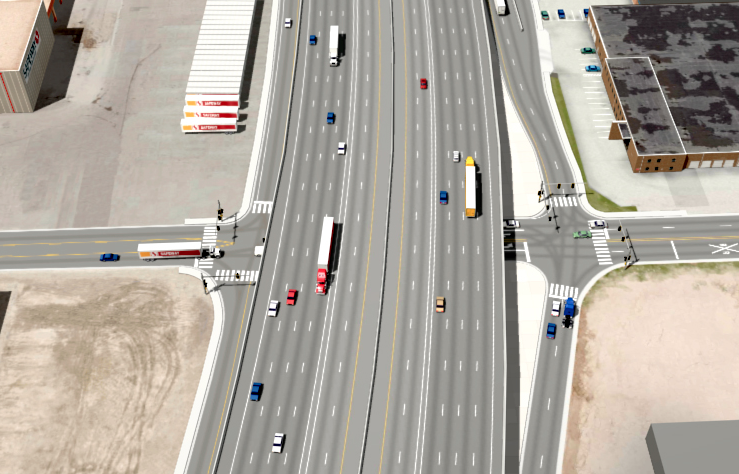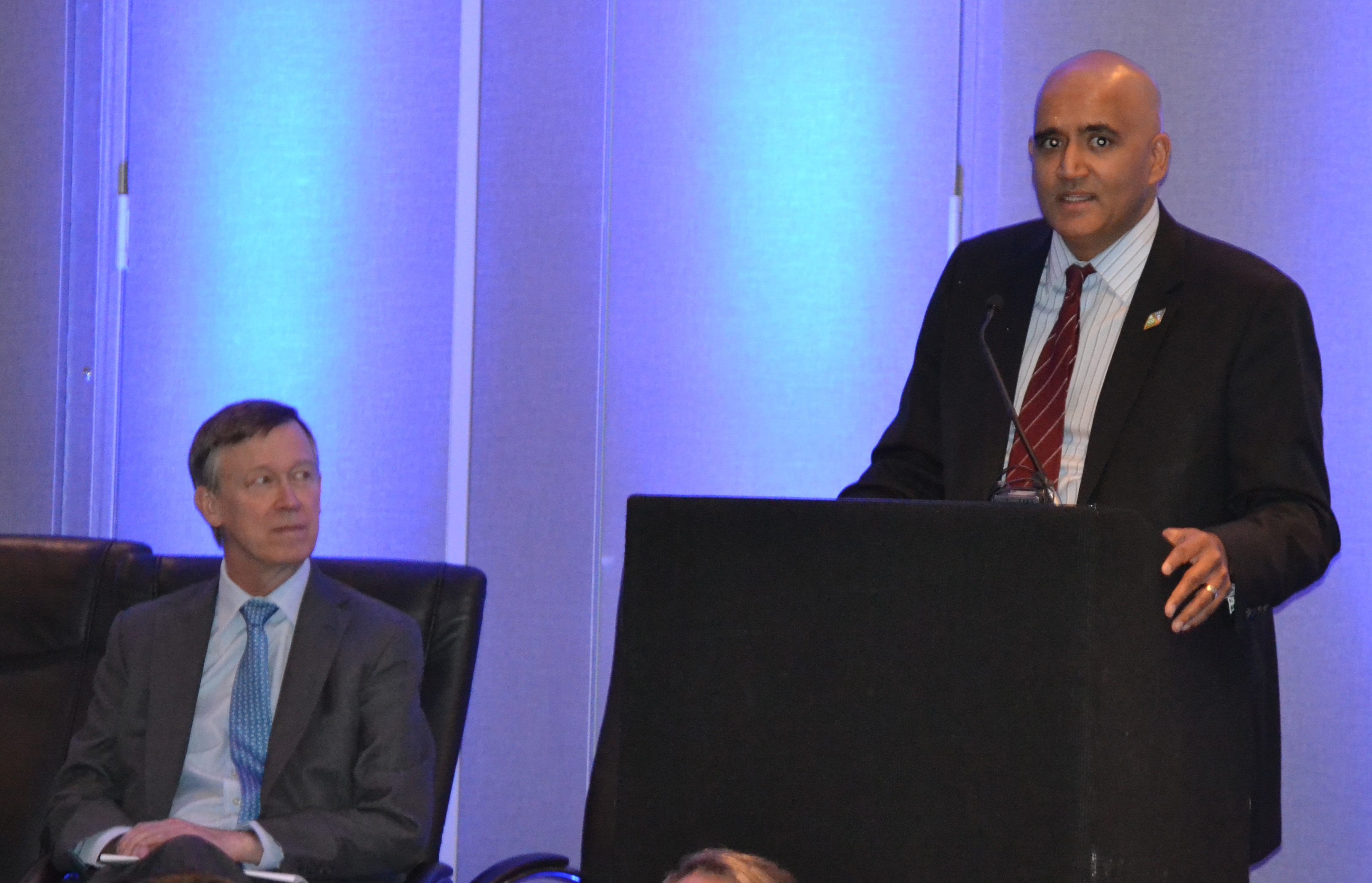CDOT Chief Shailen Bhatt on Widening I-70, Traffic Deaths, Bikes, and Transit
Yesterday Streetsblog Denver published the first half of our interview with Shailen Bhatt, the head of Colorado’s Department of Transportation, in which he talked about CDOT’s changing role in a changing Denver.

Bhatt isn’t your average DOT leader — or at least he doesn’t sound like one. He talks about complete streets a lot, and says widening roads is not the answer to congestion, though bad projects that were in the pipeline since before his time continue to move forward under his tenure.
In part two of our interview, the CDOT chief talks about the massive I-70 expansion, eliminating traffic deaths, bike infrastructure, and Colorado’s state-run bus service, Bustang.
You’ve said you agree with the principle of induced demand. And I understand that two of I-70’s four new lanes would be managed, but wouldn’t widening I-70 at all go against this well established principle? Aren’t you just making it an attractive place for more cars in the future?
One of the things I hear from opponents of the I-70 East project is that traffic growth has been capped in that corridor and isn’t growing, and they use traffic counts to back that up. I would argue that this is one place where the concerning factor is not that traffic is not going up — it’s that the road is already at capacity. I think that what you’ve got to do is make an honest guess about what the demand is in that area. It is potentially possible that only adding one lane [in each direction] might do the trick, but our traffic models don’t show that. They show increasing demand in that area.
You inherited this project. Are you saying this is the right decision if it were up to you from the beginning?
If I had been executive director 10 years ago when this all started, we would have looked at these alternatives. This has all evolved with the NEPA process, working with locals, and the city and the county and the feds and everyone else. So whether I’m here now or was here in 2005, the process would still be the same. I agree with the solution that we have right now. If this is what is acceptable to the community — and you’re never going to have 100 percent acceptance — this is the alternative that we’ve come up with through a community-driven process.
CDOT adopted the federal standard called Towards Zero Deaths: To me, it’s a more timid version of Vision Zero, which says that traffic deaths are 100 percent preventable with good design and policy. Does CDOT see zero deaths as feasible?
In my mind, there should be zero deaths. Is it realistic in the short term? Probably not — and by short term I mean the next couple of years. But I’ll tell you, the vision for Road X is a future with a collision-free, crash-free and therefore death-free roads. And that’s not far away. There are incremental steps we need to take and big things we need to do, but I can see a future where the vast majority of deaths are eliminated.

I’m glad you mentioned Road X. It’s interesting and may put Colorado at the front of the pack in terms of automated driving technology. But what about the low-tech street design solutions we already know about? Things that slow drivers down for the safety of bicyclists and pedestrians — and drivers as well — which can save lives?
I don’t think it is prudent or wise for DOTs who are making 25- and 50-year investments to stick our head in the sand and not be looking at technology. That, to me, would not be being good stewards of the transportation system. I think the whole point of Road X is that this technology is moving very quickly, and it’s going to get here, and we don’t want to be overtaken by events. We want to be working with the actors that are making these changes.
Completely separate from that is, are there low-tech, smart things that we can do right now, whether it’s striping, whether it’s bulb-outs, road diets, and narrowing of lanes, and protected bike lanes, and multimodal investments? All that stuff is not sexy but is very effective in solving our transportation problems. We absolutely need to be looking at that. And we are in many places. You look at what is the best possible solution to solve the problem. Whether it’s high-tech or low-tech, it’s about what makes the most sense.
We’ve talked about complete streets, the need for lower speeds, and narrowing lanes. You say we need to look into that, we need to discuss that, but is there a cohesive process for that?
There are a couple of processes. We work with locals. A lot of the Congestion Mitigation and Air Quality money we pass through directly to the locals. I can’t tell locals how to spend their CMAC money — that’s a local planning issue and we are a part of the conversation. For example, some locals decide they want to make ped-investments. Others say they want to do different things. So CDOT is not driving these conversations. In many cases we are simply passing through money and participating.
So for example, Hampden and Colfax — I can’t go and utilaterally make a change there. There are a lot of stakeholders. I’ve got to go out and talk to Denver, or Arapahoe, or Douglass and say, “What is it that you want?” It’s not my place to just make the decision, because — and this is the product of things that happened before I got here — that’s the process that we have.
Are you’re saying that localities need to drive decisions about streets and CDOT needs to play a supporting role?
I’m saying that different places have vastly different ideas about transportation. And then there are the legal agreements that govern all this. It’s not a one-size-fits-all and transportation solutions mean one thing in Boulder and one thing in Douglass County. Right — we want to be part of that conversation and if somebody really wants to try something out, we want to find ways to say yes as opposed to saying no.
What are the next steps for this $100 million bicycle infrastructure deal that you’ve made with the Hickenlooper administration?
We’re putting bike-ped coordinators in all of our regions, so it’s not just a headquarters thing. A lot of the projects with federal funds are already identified and will be going to construction in the next few years. And we’ll be spending $10 million to restore that [Safe Routes to School] program and infrastructure to help get kids to school safely.
Is Bustang, the state-run regional bus service, emblematic of CDOT focusing on transit and not just moving people in cars?
Absolutely. Keep in mind that I think the Nebraska Department of Roads is the last department of roads out there. These are historically monolithic structures that have been highway departments for a long time and it’s an evolution to become a Department of Transportation. We’re back in the transit business in the sense that we’re providing the service. Before we were just administering grants almost as a conduit to local agencies, which is important work. I think that the ridership has shown there is demand there. I was on a conservative talk show recently, and if there’s one thing I’ve learned in transportation, it’s that no matter what you do somebody’s going to be unhappy. We’ve just got to find that balance.
A big thing I hear around Denver is, “I would love not to own a car, but I want to be able to get to the mountains.” But Bustang only goes from the mountains to Denver in the morning, and back to the Western Slope in the afternoon and evening. Why isn’t the service more robust?
When I was in Delaware, we had very little density, a lot of fixed transit routes, and a huge amount of para-transit which is incredibly expensive — door-to-door service that we were heavily subsidizing. Our fare box recovery was 16 percent. That means that for every dollar we put into it, we’re getting 16 cents back.
I’ve read stuff that says highways are heavily subsidized and nobody factors that in. And I agree, but the difference is that they already exist. So even though there’s ridership on Bustang, we lose money on every single trip that we take. This is a philosophical question to a very difficult fiscal debate. There’s a societal benefit that exists, but we have a billion-dollar-a-year shortfall at CDOT for the next 20 years for important projects, so if I want to do more transit, I have to buy the rolling stock, I have to subsidize the service, and then the question becomes, “What am I not doing in other places?” So I guess the short answer is, if we want to do more transit, we’ve got to find out a way to pay for it.


